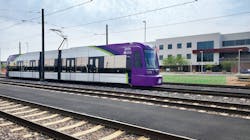Valley Metro orders 14 additional Siemens light-rail vehicles
Valley Metro in Phoenix, Ariz., has ordered 14 additional light-rail vehicles from Siemens Mobility, which will be manufactured at the company’s Sacramento, Calif., facility and help Valley Metro serve riders on an expanding rail network.
Valley Metro originally ordered 11 light-rail vehicles in 2017 and the additional S700 vehicles will bring the total up to 25.
“Additional light-rail fleet supports our mission of connecting communities, especially as we close in on the 2024 completion date of South Central Extension/Downtown Hub,” said Scott Smith, Valley Metro CEO. “As our transit system grows, so must our fleet to accommodate new miles of service and additional riders across metro Phoenix.”
“Phoenix is currently the fifth largest city in the U.S. and continues to lead the country in population growth,” said Michael Cahill, president of Siemens Mobility in North America. “Sustainable transportation is one of the most important features for tomorrow’s cities, and we applaud Valley Metro’s foresight in continuing to stay on-course with the future needs of their residents.”
Based on Siemens Mobility’s S700 platform, the light-rail vehicles will offer a larger interior, energy-efficient LED lighting and feature heavy-duty air conditioning systems that will help keep the Phoenix area riders comfortable in a climate known to reach temperatures of up to 120 degrees (F). This fleet will also feature a newly designed front-end bumper designed for collision impact mitigation.
Siemens Mobility says the S700 low-floor light-rail vehicles are known for their low-level boarding at every doorway, spacious seating design and larger windows for better light and views. They feature improved accessibility with wider aisles and storage space for bicycles. In addition, the vehicles have improved performance and optimized availability provided by condition monitoring, remote diagnostics and predictive maintenance.
